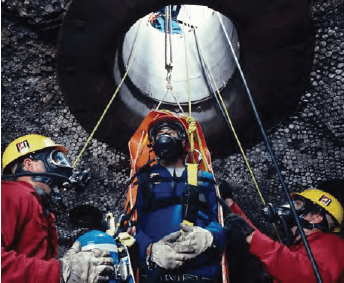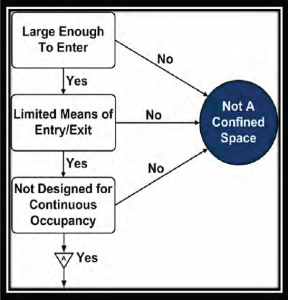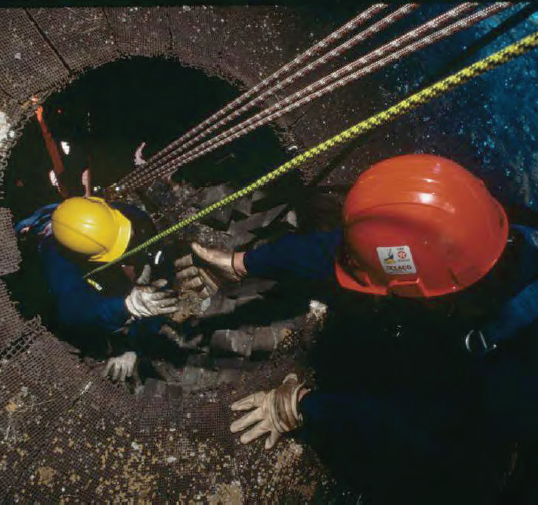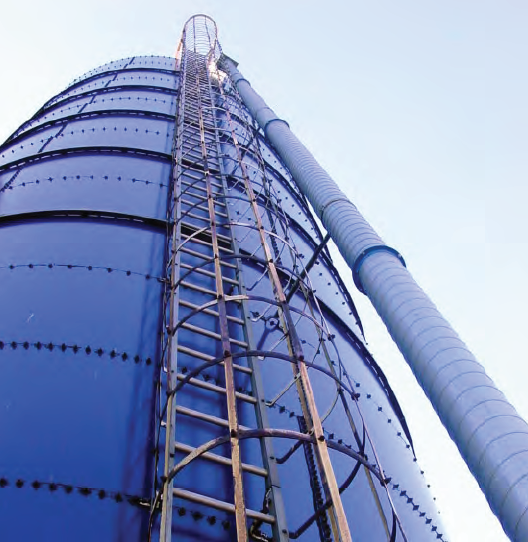
Understanding Confined Space Standards
By Jerome E. Spear, CIH, CSP, FAIHA
According to the Occupational Safety and Health Administration (OSHA), one death occurs in every 10 confined space accidents. Injuries and fatalities involving confined spaces often involve successive fatalities when “would-be” rescuers succumb to the same problem as the initial victim. Almost every kind of industry has some type of confined spaces. Tanks, storage bins, tunnels, pipelines, utility vaults, pits, storm drains, and silos are examples of confined spaces. More than 1.5 million workers enter these spaces each year for the purposes of maintenance, repairs, installations, and inspections. Employees who work in confined spaces face an increased risk to serious physical injury from hazards such as entrapment, engulfment and/or hazardous atmospheric conditions. Evaluating potential hazards and understanding applicable confined space standards is the first step to preventing confined space accidents.
Definitions
The term “permit-required confined space” refers to spaces that meet the Occupational Safety and Health Administration’s (OSHA’s) definition of a confined space and contain recognized serious health or safety hazards. For this reason, OSHA requires workers to have a permit to enter these spaces. In order to know whether the space requires a permit, the first task for employers is to recognize what constitutes a confined space. By definition, a confined space has three requirements according to OSHA’s general industry confined space standard, all of which must be present.
- A confined space is large enough for an employee to enter fully and perform assigned work.
- A confined space is not designed for continuous occupancy by the employee.
- A confined space has a limited or restricted means of entry or exit.
OSHA’s confined space standard is written in performance oriented language, outlining the requirements employers must take. The precautions and controls for each confined space is based on a hazard evaluation of the space. As each space is unique, it is the employer’s responsibility to evaluate the hazards of the confined space. Based on the identified hazards, the space is then classified as a permit-required or non-permit confined space.
A permit-required confined space has one or more of these characteristics:
- Contains or has the potential to contain a hazardous atmosphere
- Contains a material with the potential to engulf someone who enters the space
- Has an internal configuration that might cause an worker to be trapped or asphyxiated by inwardly converging walls or by a floor that slopes downward and tapers to a smaller cross section
- Contains any other recognized serious safety or health hazards.
Standards
Employers in general industry must evaluate their workplaces to determine if spaces are permit spaces. If a workplace contains permit spaces, the employer must inform exposed employees of their existence, location, and the hazards they pose. Additionally, employers must prevent unauthorized entry into confined spaces. The best method to prevent unauthorized entry is to fully secure the entry portals with bolted connections or other equivalent means. Alternative means to prevent unauthorized entry may be accomplished by a combination of posting danger signs and conducting confined space awareness training. If employees are expected to enter permit spaces, the employer must develop a written permit space program and make it available to employees or their representatives.
 OSHA’s general industry regulation (29 CFR 1910.146, Permit-Required Confined Spaces) specifically states that this regulation does not apply to the construction industry due to the differences in the nature of the work sites. However, contractors performing maintenance work at a host employer’s facility may be bound by law to comply with 29 CFR 1910.146. Examples of “maintenance” operations include cleaning, inspecting, repainting, and/or replacing components similar to the existing structure. Construction operations consist of the reconfiguration or installation of substantially new equipment. If the work is considered “construction,” the general industry standards do not apply.
OSHA’s general industry regulation (29 CFR 1910.146, Permit-Required Confined Spaces) specifically states that this regulation does not apply to the construction industry due to the differences in the nature of the work sites. However, contractors performing maintenance work at a host employer’s facility may be bound by law to comply with 29 CFR 1910.146. Examples of “maintenance” operations include cleaning, inspecting, repainting, and/or replacing components similar to the existing structure. Construction operations consist of the reconfiguration or installation of substantially new equipment. If the work is considered “construction,” the general industry standards do not apply.
OSHA’s provisions for confined spaces in construction (29 CFR 1926, subpart AA) are similar to the confined space provisions for general industry worksites; however, there are five notable differences:
- More detailed provisions requiring coordinated activities when there are multiple employers at the worksite. The controlling contractor is in the best position to convey information to other employers at the worksite. These provisions also attempt to prevent hazards being introduced into a confined space by workers performing tasks outside the space. An example would be a generator running near the entrance of a confined space that could cause a buildup of carbon monoxide within the space. The construction rule makes the controlling contractor, rather than the host employer, the primary point of contact for information about permit spaces at the work site (see Figure 1).
- Incorporating the term, “competent person,” with the same definition for this term as contained in other OSHA construction standards. A competent person means a person capable of identifying existing and predictable hazardous conditions, and who has the authority to address them promptly. The construction standard requires that a competent person evaluate the worksite and identify confined spaces, including permit spaces.
- Requiring continuous atmospheric monitoring whenever possible.
- Requiring early warning systems that continuously monitors non-isolated engulfment hazards. For example, when workers are performing work in a storm sewer, a storm upstream from the workers could cause flash flooding. An electronic sensor or observer posted upstream from the work site could alert workers in the space at the first sign of the hazard, giving the workers time to evacuate the space safely.
- Allowing for the suspension of a permit, instead of cancellation, in the event of changes from the entry conditions list on the permit or an unexpected event requiring evacuation of the space. The space must be returned to the entry conditions listed on the permit before re-entry.

In addition, OSHA includes provisions in the construction rule that clarifies existing requirements in the general industry standard. These include:
- Requiring employers who direct workers to enter a space without using a complete permit system prevent potential hazards in confined spaces through elimination of the hazard(s) or isolation methods such as lockout/tagout procedures.
- Requiring employers who are relying on local emergency services for emergency services arrange for responders to give the employer advance notice if they will be unable to respond for a period of time (because they are responding to another emergency, attending department-wide training, etc.).
- Requiring employers to provide training in a language and vocabulary that the worker understands.
Detecting and Controlling Hazardous Conditions
Potential hazards in a confined space could be:
- A hazardous atmosphere (the most common threat)
- Hazardous liquids or solid materials
- Thermal, mechanical or electrical hazards
- Noise
- Slips and trips
- Any situation in which self-rescue was not possible
Permit-required confined space entry is not allowed until effective procedures are followed to allow safe entry. The employer having control over the confined space operation must ensure effective means have been taken to prevent unauthorized entry. Prior to entry, the entry supervisor is responsible for assessing the hazards and issuing a permit to ensure potential hazards are adequately controlled and/or eliminated.
Some examples of how to control or lessen potential hazards in a confined space include isolating the permit space by physically blanking or blinding lines to the space, purging and ventilating the space, and conducting atmospheric monitoring before and during entry. Ventilation equipment should be grounded and bonded to avoid static discharges that may ignite flammable atmospheres. Mechanical, electrical, stored, and other sources of energy should be de-energized or otherwise rendered in its zero energy state and locked out/tagged out (LOTO) in accordance with the employer’s LOTO program. A standby attendant and a rescue plan must be in place for permit space entry operations.
Employees must immediately leave the space if hazardous conditions are detected during entry. The employer must evaluate the space to determine the cause of the hazardous condition and modify the program as necessary. A new permit must be issued by the entry supervisor before work may resume inside the space.
Non-permit confined spaces must be evaluated when changes occur in their use or configuration, and where appropriate, must be reclassified as permit spaces. A space with no potential to have atmospheric hazards or other recognized serious hazards may be classified as a non-permit confined space only when serious hazards are eliminated in accordance with OSHA’s standard. If entry is required to eliminate hazards and/or obtain data, the employer must follow permit-required entry procedures until the employer is able to validate that the hazards are eliminated.
Worker Training
Training is critical for confined space entry operations. Before work begins, the employer must provide proper training for all workers who are required to enter permit spaces. After the training, employers must ensure that the employees have acquired the understanding, knowledge and skills necessary to safely perform their duties.

In addition, a standby attendant must be trained to remain outside permit spaces during entry operations. The standby attendant must maintain communication with, and keep an accurate list of workers entering the permit space. The attendant is also responsible for ordering an evacuation of the permit space when a prohibited condition occurs, summoning rescue and other services during an emergency, and ensuring that unauthorized people stay away from the permit space.

An emergency rescue plan, along with the necessary rescue equipment, must be in place prior to entry into permit spaces. In an emergency, entrants shall be removed from a permit space in a timely manner, preferably within four minutes. Rescue service personnel must be provided with personal protective and rescue equipment, including respirators, and training in how to use it. Simulated practice rescue exercises shall be performed at least once a year. Rescuers must also be informed of the hazards of the permit space.
An emergency rescue plan, along with the necessary rescue equipment, must be in place prior to entry into permit spaces. In an emergency, entrants shall be removed from a permit space in a timely manner, preferably within four minutes. Rescue service personnel must be provided with personal protective and rescue equipment, including respirators, and training in how to use it. Simulated practice rescue exercises shall be performed at least once a year. Rescuers must also be informed of the hazards of the permit space.

In summary, the main difference between permit and non-permit confined space is that a permit space has serious recognized hazards, whereas such hazards are not present or have been eliminated for a non-permit confined space. A permit space requires a permit, a rescue plan (and rescue equipment readily available) and a standby attendant. If the space had a hazardous atmosphere that has been effectively eliminated through isolation (blinding/blanking), cleaning, purging, and ventilation – and verified by atmosphere testing – the space may be reclassified as non-permit space. But even after reclassification, the atmosphere inside the non-permit space should be regularly monitored to verify that hazardous atmospheres remain effectively eliminated and that no hazardous atmosphere develops inside the space due to work activities performed by employees who enter the space.


Share This Article!

